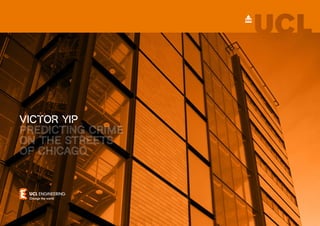
Case Study - Victor
- 1. VICTOR YIP PREDICTING CRIME ON THE STREETS OF CHICAGO
- 2. VICTOR YIP PREDICTING CRIME ON THE STREETS OF CHICAGO. Can we predict crimes using data science? This project investigates the occurrence of crimes in Chicago in relation to the spatial and Twitter data obtained between mid April to mid May 2016. Descriptive analysis of crime data is common but our project pushes it a step further to demonstrate the predictive capability of widely available data by using machine learning techniques. Task: I am part of a team of three students from MSc Business Analytics. We leveraged techniques from natural language processing (NLP), kernel density estimate and support vector machines using crime data from the Chicago Open Data Portal and Twitter to model and provide probabilistic estimation of future crime occurrence in Chicago. Review: We offer our solution through an interactive website with the aim of assisting the Chicago government and police force to more strategically mobilize patrol force to places with a high probability of crime. The interactive website also serves as a tool for the wider public to understand crime statistics in the city. This project is unique in three ways. It it is a easily accessible tool despite the complicated model it is based on. It is a real-time tool that takes in live action on Twitter and the latest crime data to update its prediction. And finally, it provides a point estimate so that no street corner in Chicago is missed out.
- 3. Q&A WE SAT DOWN WITH VICTOR AND ASKED HIM A FEW QUESTIONS ABOUT HIS PROJECT AND ASK WHAT HE THINKS THE FUTURE HOLDS FOR HIMSELF. What makes this project unique? This project is unique in three ways. Firstly, it is a easily accessible tool despite being based on a complicated model. Secondly, it is a real-time tool that takes in live action on Twitter and the latest crime data. Thirdly, it provides a point estimate so that no street corner in Chicago is ever missed out. What was the moment you realised you wanted to do what you’re doing today? I spent 4 years in finance in a leading investment bank in Hong Kong. It was a great experience with very dedicated and smart people. But it was not forward thinking in terms of technology innovation. I realised that instead of relying on someone else to code an idea, I could go deeper down this vertical to learn coding by myself. What’s your biggest career highlight? Obviously there is a lot more to be done. But I was really happy to deliver on a year-long project at Asia Pacific to revamp the process of international function relocation. What motto do you live your life by? It is not the hours you put in but what you put in the hours. The purpose of life is to find your gift, the goal of life is to give it away. Share one big trend emerging in engineering and why it’s important? Artificial intelligence. I have only been scratching the surface of this domain in the past year. I am curious to see how AI will replace human productivity and how it will impact society. What excites you about the opportunities with data today and in the future? Hidden patterns and trends that we might have never envisioned. I am very excited to be alive at the era of data-enabled proliferation. //// “It is not the hours you put in but what you put in the hours”
